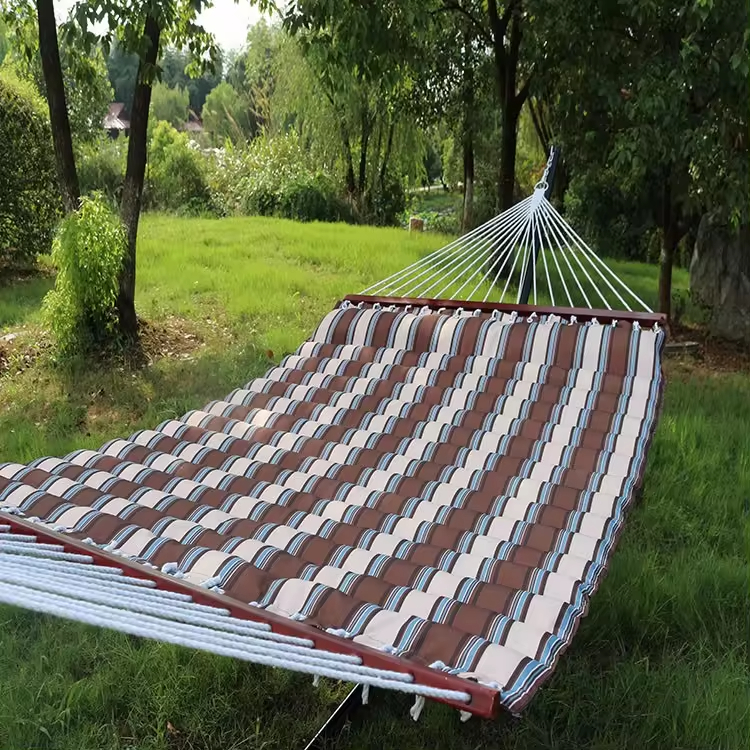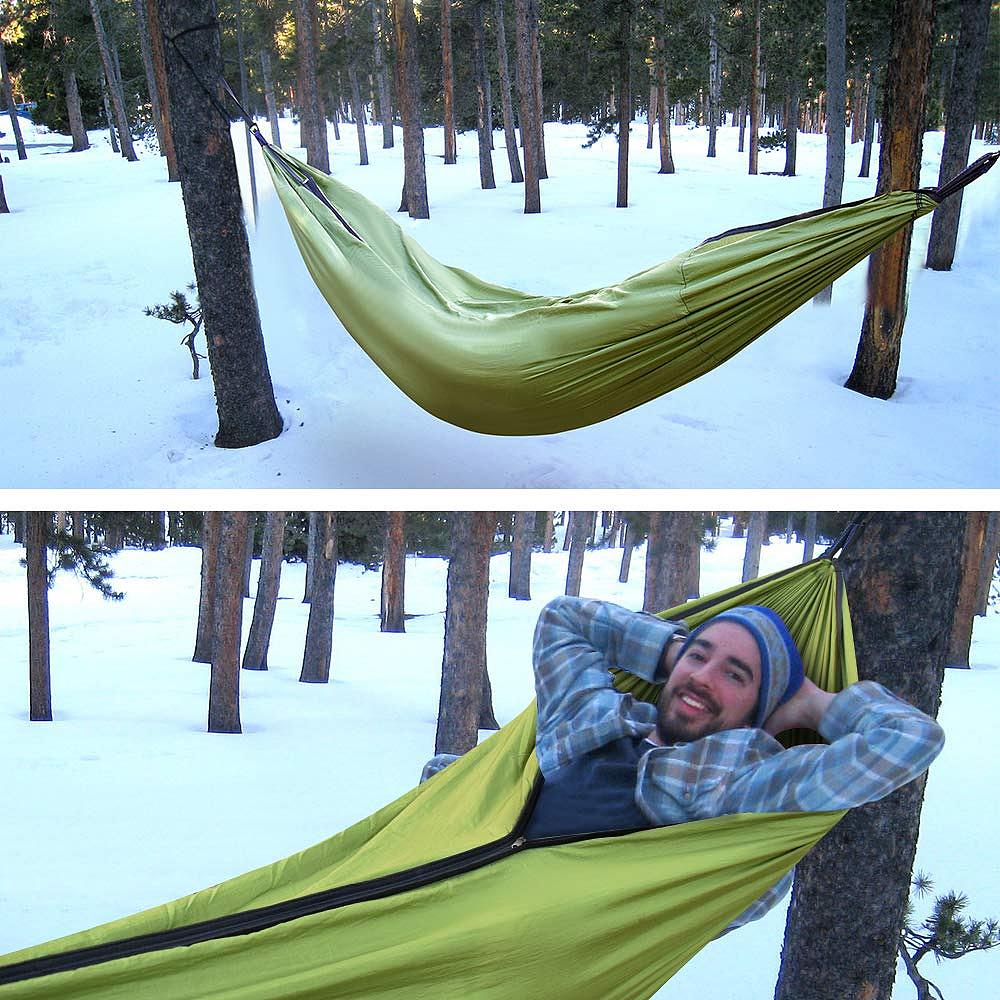Introduction: Unlocking the Magic of Winter Hammock Camping
Winter hammock camping offers a unique and exhilarating outdoor experience, allowing adventurers to immerse themselves in the serene beauty of nature while enjoying the cozy comfort of a hammock. As the temperatures drop and the snow blankets the landscape, there’s no better time to embrace the chill and embark on a winter camping adventure. In this comprehensive guide, we’ll explore everything you need to know to plan and enjoy a memorable winter hammock camping trip.

Choosing the Right Gear: Essential Equipment for Winter Hammock Camping
Before venturing into the winter wilderness, it’s essential to gather the right gear to ensure a safe and comfortable camping experience.
- Insulated Hammock: Invest in a high-quality hammock designed for winter camping, equipped with built-in insulation or compatible with aftermarket insulation systems. Look for hammocks with features like underquilts and top quilts to provide warmth and insulation from the cold ground and chilly air.
- Sleeping System: Choose a warm and insulating sleeping pad or underquilt to protect against heat loss from below. Pair it with a cozy sleeping bag rated for cold temperatures, ensuring you stay snug and comfortable throughout the night.
- Tarp or Rainfly: Shield yourself from the elements by setting up a durable tarp or rainfly above your hammock. Opt for a spacious and weather-resistant tarp to provide ample coverage and protection from snow, rain, and wind.
- Layered Clothing: Dress in layers to regulate your body temperature and stay warm in fluctuating weather conditions. Pack moisture-wicking base layers, insulating mid-layers, and a waterproof outer shell to stay dry and comfortable throughout your camping trip.
- Winter Accessories: Don’t forget essential winter accessories like insulated gloves, hats, scarves, and wool socks to keep extremities warm and prevent frostbite. Additionally, consider bringing hand warmers or heated packs for extra warmth during chilly nights.

Selecting the Perfect Campsite: Finding the Ideal Winter Wonderland
Choosing the right campsite is crucial for a successful winter hammock camping trip, ensuring both safety and enjoyment amidst the snowy landscape.
- Accessibility: Look for campsites with easy access and suitable terrain for setting up your hammock and gear. Avoid steep slopes or areas prone to avalanches, and consider proximity to water sources for cooking and hydration.
- Wind Protection: Seek out sheltered areas or natural windbreaks, such as dense forests or rock formations, to minimize exposure to cold winds and improve overall comfort at your campsite.
- Sun Exposure: Prioritize campsites with ample sunlight exposure during the day to help melt snow, dry gear, and provide warmth. Position your hammock to catch the morning sun and avoid shaded areas that remain cold and damp.
- Safety Considerations: Assess potential risks and hazards, such as falling branches, unstable snowpack, or wildlife activity, when selecting a campsite. Choose a location away from potential dangers and follow Leave No Trace principles to minimize environmental impact.
- Scenic Beauty: Embrace the tranquility and beauty of winter landscapes by selecting campsites with breathtaking views of snow-capped mountains, frozen lakes, or towering evergreen forests. Opt for locations that inspire awe and wonder, enhancing the overall experience of your winter camping adventure.

Mastering Cold Weather Techniques: Tips for Staying Warm and Cozy
Winter hammock camping requires specialized techniques and strategies to stay warm and comfortable in frigid conditions. Follow these tips to master the art of cold weather camping:
- Insulation Optimization: Maximize insulation by adjusting your hammock setup to minimize air circulation and heat loss. Use additional insulation layers, such as reflective foam pads or synthetic underquilts, to enhance warmth and comfort during chilly nights.
- Strategic Windbreaks: Erect windbreaks or snow barriers around your campsite using tarps, fallen branches, or snow walls to block cold winds and create a sheltered microclimate. Position your hammock close to natural windbreaks for added protection and warmth.
- Hot Water Bottle Hack: Fill a durable water bottle with hot water before bedtime and place it inside your sleeping bag to provide warmth and heat retention throughout the night. Alternatively, use insulated water bottles as makeshift hand warmers to keep extremities toasty in cold weather.
- Layered Insulation: Layer insulation beneath and around your hammock to trap heat and create a cozy sleeping environment. Utilize blankets, sleeping pads, or spare clothing to fill gaps and prevent cold drafts from penetrating your sleep system.
- Pre-Warming Ritual: Warm up your sleeping bag and hammock before bedtime by using body heat or gentle exercise to generate warmth. Shake out frost and snow from your gear, and ensure that your sleeping area is dry and free of moisture to prevent heat loss.

Winter camping poses unique challenges and hazards that require careful preparation and risk management to ensure a safe and enjoyable experience.
- Hypothermia Prevention: Stay vigilant for signs of hypothermia, such as shivering, confusion, and numbness, and take immediate action to warm up if symptoms occur. Dress in dry layers, stay hydrated, and avoid prolonged exposure to cold temperatures to reduce the risk of hypothermia.
- Avalanche Awareness: Educate yourself about avalanche safety and terrain hazards before venturing into snowy landscapes. Avoid traveling in avalanche-prone areas, and always carry essential avalanche safety gear, including a beacon, probe, and shovel, when exploring backcountry terrain.
- Fire Safety: Exercise caution when building campfires or using camp stoves in winter conditions, as snow and cold temperatures can increase fire hazards. Clear snow away from the fire pit, use a sturdy fire ring or platform, and keep a safe distance from flammable materials to prevent accidents and wildfires.
- Emergency Preparedness: Prepare for emergencies by carrying essential survival gear, including a first aid kit, emergency shelter, navigation tools, and communication devices. Share your itinerary with trusted contacts, familiarize yourself with evacuation routes, and know how to signal for help in case of an emergency.
- Leave No Trace Ethics: Practice Leave No Trace principles to minimize environmental impact and preserve the natural beauty of winter wilderness areas. Pack out all trash, avoid disturbing wildlife, and minimize campsite alterations to leave the landscape pristine for future generations to enjoy.

Delicious Hot Meals: Cooking Tips for Winter Hammock Camping
When embarking on a winter hammock camping trip, it’s essential to fuel your adventure with hearty and delicious meals that provide warmth and nourishment. Here are some cooking tips and meal ideas to keep you satisfied during your winter camping experience:
- Hot Drinks for Warmth: Start your day with a steaming cup of hot coffee, tea, or cocoa to warm you from the inside out. Invest in a portable camp stove or use a thermos to keep your beverages piping hot throughout the day.
- One-Pot Wonders: Simplify your cooking setup by preparing one-pot meals that are easy to cook and require minimal cleanup. Consider dishes like hearty stews, chili, or pasta that can be cooked in a single pot or Dutch oven over a campfire or stove.
- Prep and Pack Ahead: Prepare and pre-measure ingredients at home to streamline your cooking process at the campsite. Store ingredients in separate containers or resealable bags to save space and prevent any spills or leaks.
- Freeze-Dried Meals: Pack lightweight and easy-to-prepare freeze-dried meals for quick and convenient dinners. These meals often require only boiling water and a few minutes of rehydration, making them ideal for winter camping when time and energy are valuable.
- Winter Comfort Foods: Embrace the cold weather with comforting meals like warm soups, grilled cheese sandwiches, or roasted sausages. These classic winter comfort foods are simple to prepare and will keep you cozy and satisfied during your camping trip.
Conclusion: Embracing the Adventure of Winter Hammock Camping
Winter hammock camping offers a one-of-a-kind outdoor adventure, inviting intrepid explorers to immerse themselves in the tranquil beauty of snow-covered landscapes and starlit skies. By choosing the right gear, selecting the perfect campsite, mastering cold weather techniques, and prioritizing safety, you can enjoy a safe and memorable camping experience even in the coldest of conditions.
So, embrace the chill, bundle up in your cozy sleeping bag, and let the serenity of winter wilderness surround you as you embark on an unforgettable journey into the heart of nature. Whether you’re seeking solitude amidst snowy forests or bonding with friends around a crackling campfire, winter hammock camping promises moments of magic and wonder that will stay with you long after the snow has melted away.
